Final Accounts Preparation: Sole Traders and Partnerships - Analysis
VerifiedAdded on 2020/10/22
|18
|4469
|364
Report
AI Summary
This report delves into the intricacies of preparing final accounts for sole traders and partnerships. It begins by outlining the reasons for closing accounts and producing a trial balance, as well as the processes and limitations involved. The report then covers the methods of constructing accounts from incomplete records, reasons for imbalances and incomplete records. The core of the report focuses on practical applications, including calculating opening and closing capital and cash/bank balances. It covers sales and purchase ledger control accounts and the use of markups and margins. The report also meticulously details the components of final accounts for a sole trader, including the statement of profit and loss and the statement of financial position. The report extends to partnerships, outlining key components of partnership agreements and accounts, including profit and loss appropriation accounts, partner capital and current accounts. Finally, it addresses the calculation of closing balances on partner accounts and the preparation of the statement of financial position in compliance with the partnership agreement.
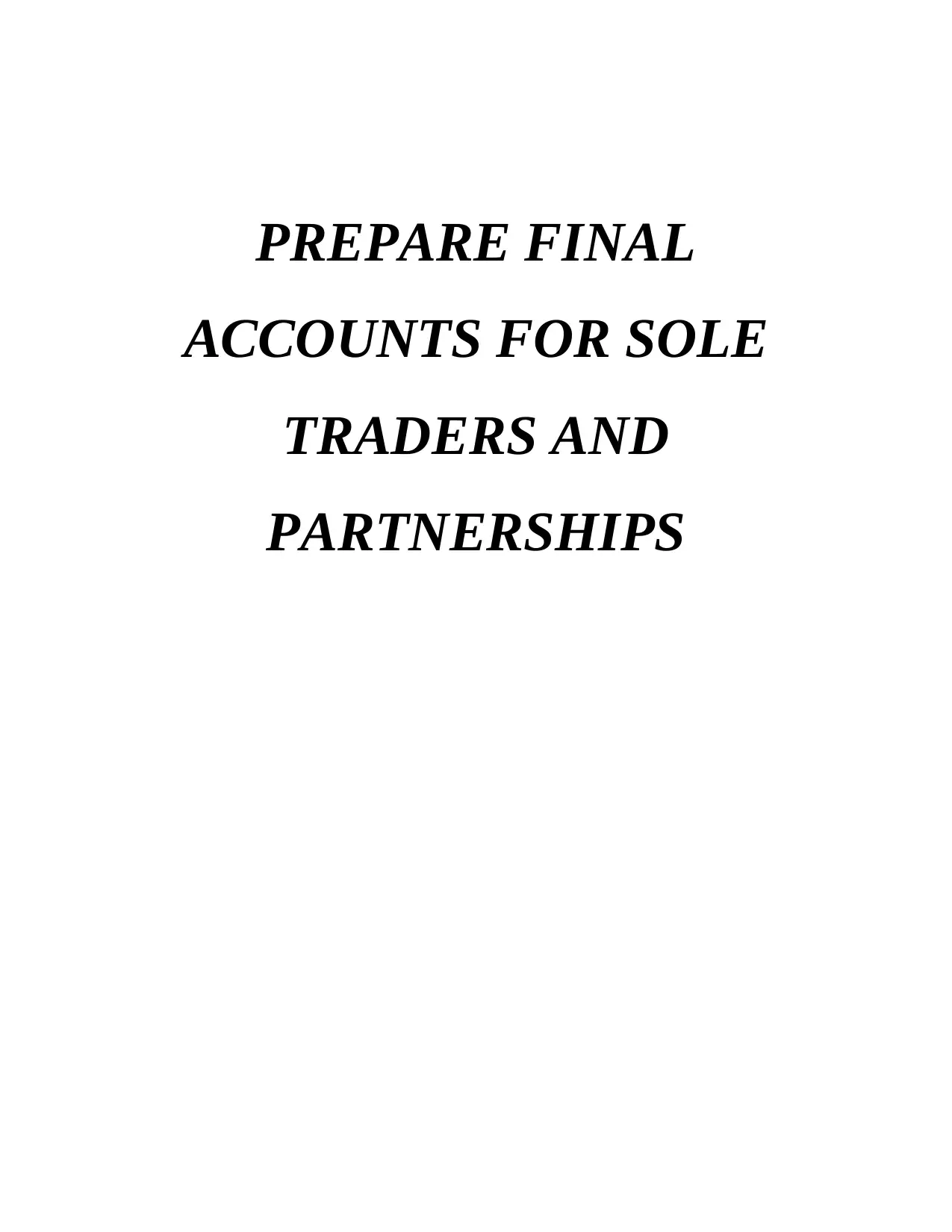
PREPARE FINAL
ACCOUNTS FOR SOLE
TRADERS AND
PARTNERSHIPS
ACCOUNTS FOR SOLE
TRADERS AND
PARTNERSHIPS
Paraphrase This Document
Need a fresh take? Get an instant paraphrase of this document with our AI Paraphraser
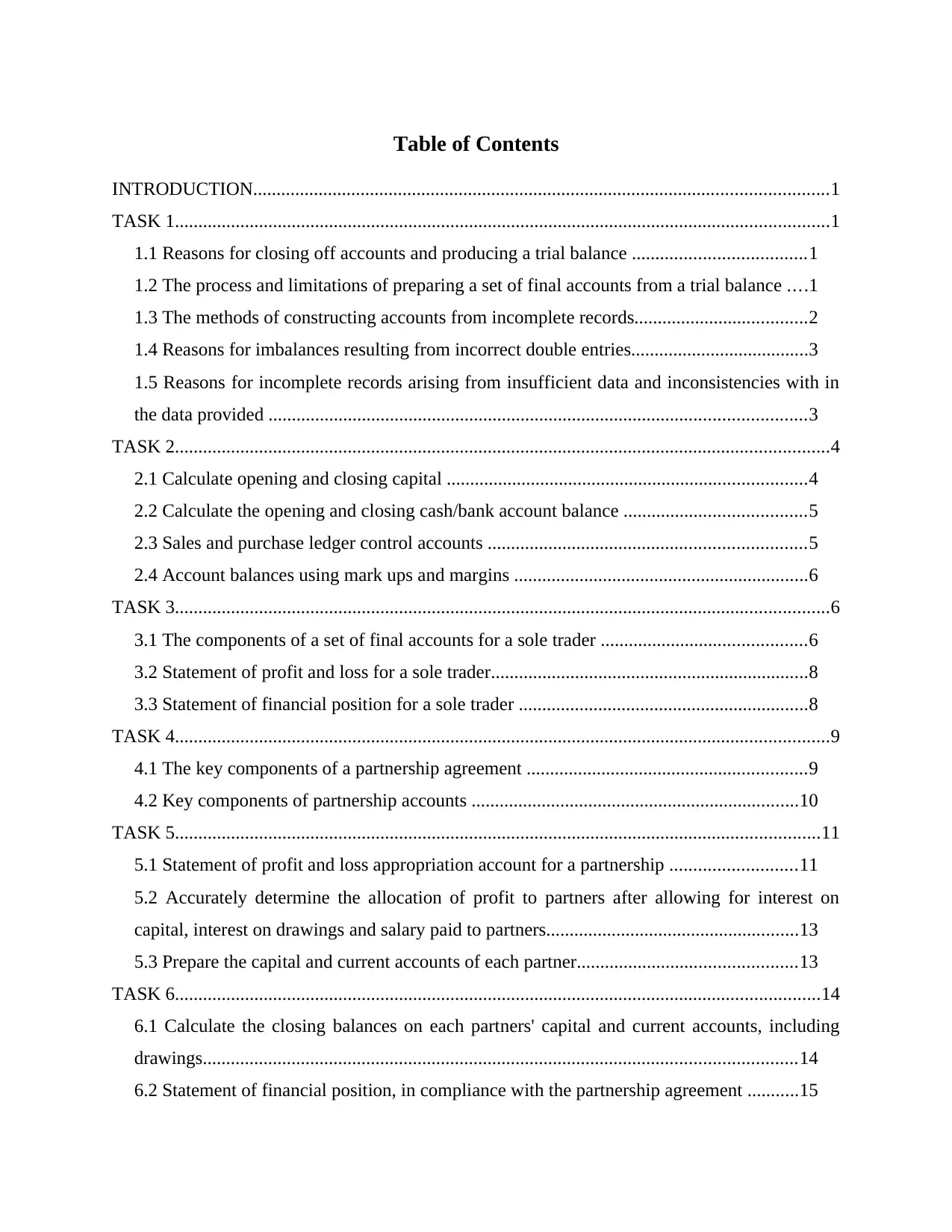
Table of Contents
INTRODUCTION...........................................................................................................................1
TASK 1............................................................................................................................................1
1.1 Reasons for closing off accounts and producing a trial balance .....................................1
1.2 The process and limitations of preparing a set of final accounts from a trial balance ....1
1.3 The methods of constructing accounts from incomplete records.....................................2
1.4 Reasons for imbalances resulting from incorrect double entries......................................3
1.5 Reasons for incomplete records arising from insufficient data and inconsistencies with in
the data provided ...................................................................................................................3
TASK 2............................................................................................................................................4
2.1 Calculate opening and closing capital .............................................................................4
2.2 Calculate the opening and closing cash/bank account balance .......................................5
2.3 Sales and purchase ledger control accounts ....................................................................5
2.4 Account balances using mark ups and margins ...............................................................6
TASK 3............................................................................................................................................6
3.1 The components of a set of final accounts for a sole trader ............................................6
3.2 Statement of profit and loss for a sole trader....................................................................8
3.3 Statement of financial position for a sole trader ..............................................................8
TASK 4............................................................................................................................................9
4.1 The key components of a partnership agreement ............................................................9
4.2 Key components of partnership accounts ......................................................................10
TASK 5..........................................................................................................................................11
5.1 Statement of profit and loss appropriation account for a partnership ...........................11
5.2 Accurately determine the allocation of profit to partners after allowing for interest on
capital, interest on drawings and salary paid to partners......................................................13
5.3 Prepare the capital and current accounts of each partner...............................................13
TASK 6..........................................................................................................................................14
6.1 Calculate the closing balances on each partners' capital and current accounts, including
drawings...............................................................................................................................14
6.2 Statement of financial position, in compliance with the partnership agreement ...........15
INTRODUCTION...........................................................................................................................1
TASK 1............................................................................................................................................1
1.1 Reasons for closing off accounts and producing a trial balance .....................................1
1.2 The process and limitations of preparing a set of final accounts from a trial balance ....1
1.3 The methods of constructing accounts from incomplete records.....................................2
1.4 Reasons for imbalances resulting from incorrect double entries......................................3
1.5 Reasons for incomplete records arising from insufficient data and inconsistencies with in
the data provided ...................................................................................................................3
TASK 2............................................................................................................................................4
2.1 Calculate opening and closing capital .............................................................................4
2.2 Calculate the opening and closing cash/bank account balance .......................................5
2.3 Sales and purchase ledger control accounts ....................................................................5
2.4 Account balances using mark ups and margins ...............................................................6
TASK 3............................................................................................................................................6
3.1 The components of a set of final accounts for a sole trader ............................................6
3.2 Statement of profit and loss for a sole trader....................................................................8
3.3 Statement of financial position for a sole trader ..............................................................8
TASK 4............................................................................................................................................9
4.1 The key components of a partnership agreement ............................................................9
4.2 Key components of partnership accounts ......................................................................10
TASK 5..........................................................................................................................................11
5.1 Statement of profit and loss appropriation account for a partnership ...........................11
5.2 Accurately determine the allocation of profit to partners after allowing for interest on
capital, interest on drawings and salary paid to partners......................................................13
5.3 Prepare the capital and current accounts of each partner...............................................13
TASK 6..........................................................................................................................................14
6.1 Calculate the closing balances on each partners' capital and current accounts, including
drawings...............................................................................................................................14
6.2 Statement of financial position, in compliance with the partnership agreement ...........15
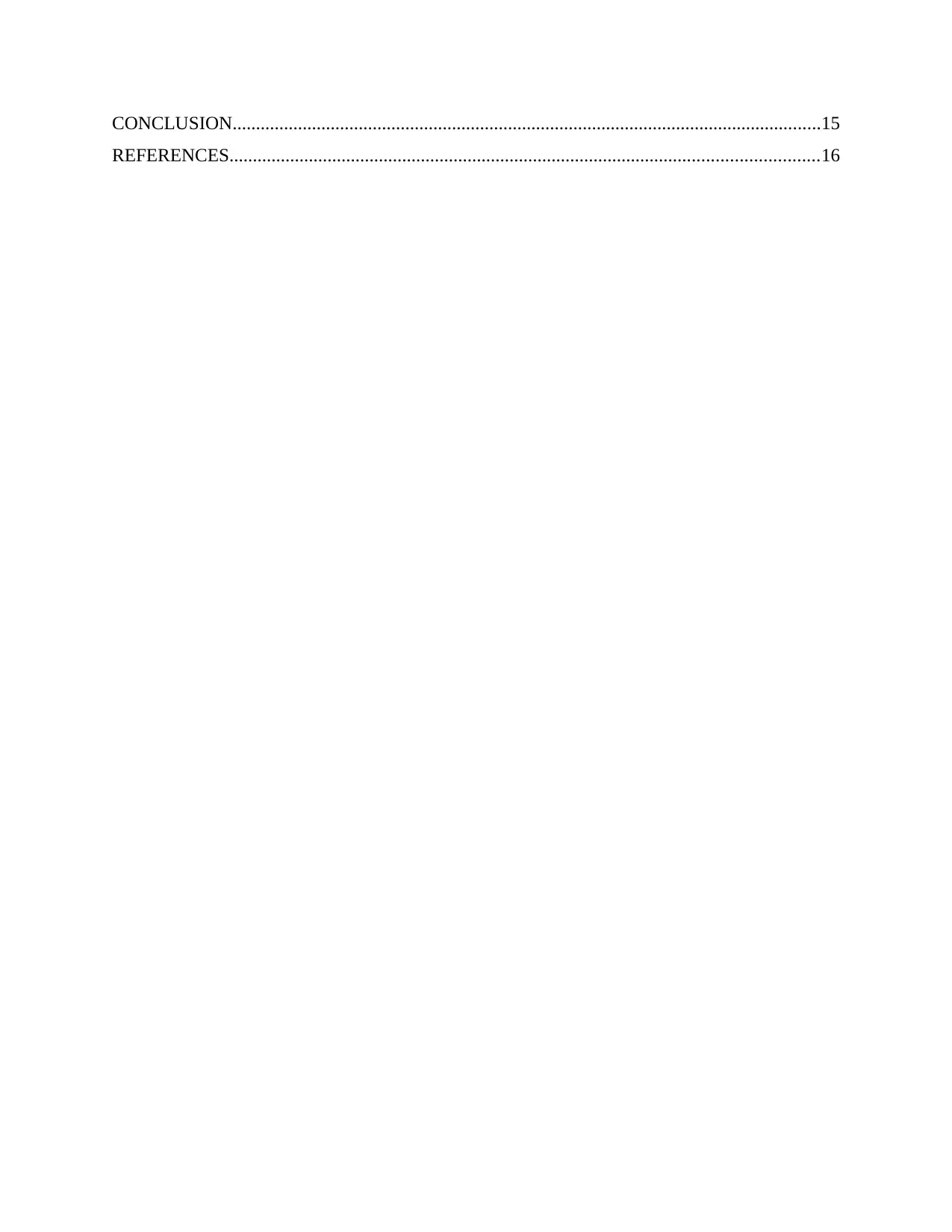
CONCLUSION..............................................................................................................................15
REFERENCES..............................................................................................................................16
REFERENCES..............................................................................................................................16
⊘ This is a preview!⊘
Do you want full access?
Subscribe today to unlock all pages.

Trusted by 1+ million students worldwide
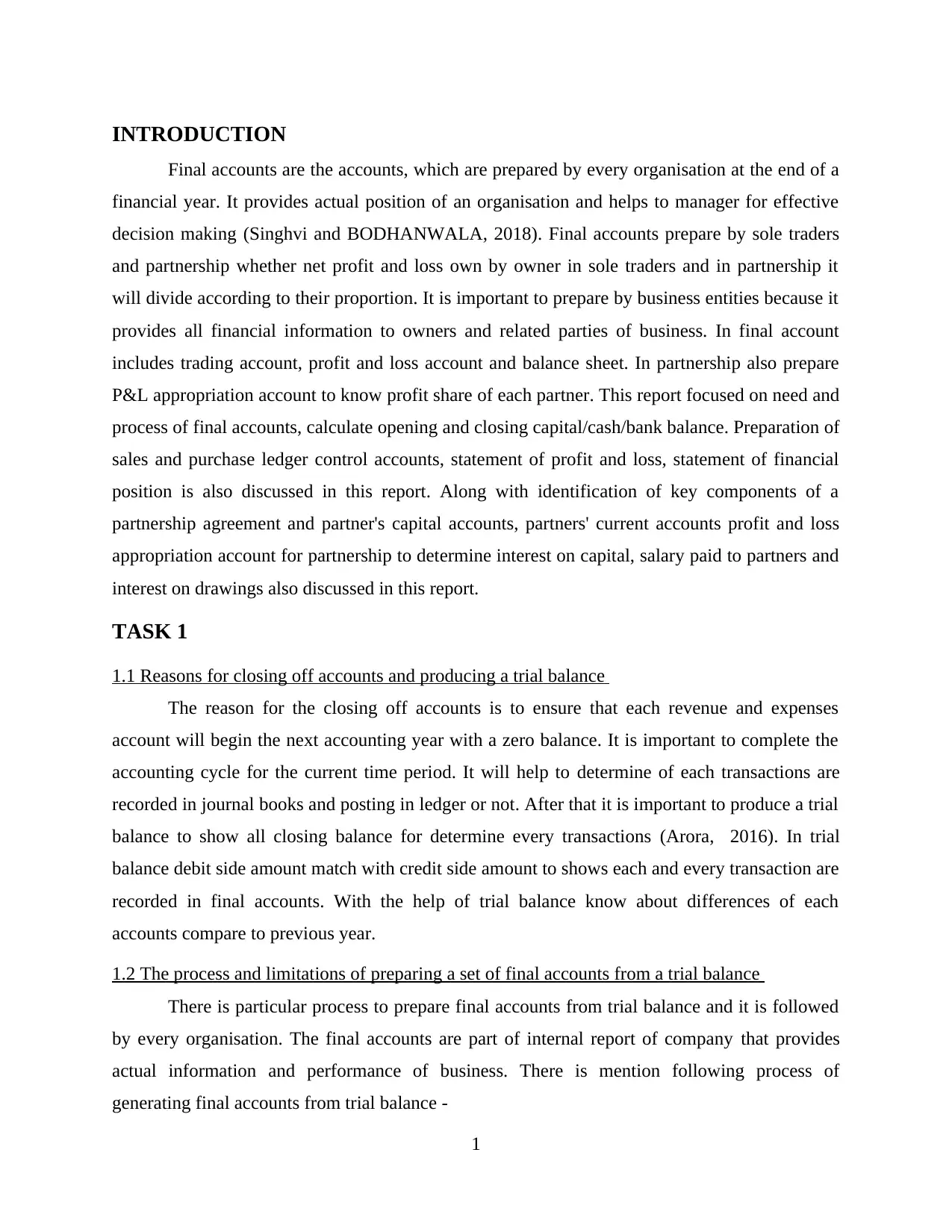
INTRODUCTION
Final accounts are the accounts, which are prepared by every organisation at the end of a
financial year. It provides actual position of an organisation and helps to manager for effective
decision making (Singhvi and BODHANWALA, 2018). Final accounts prepare by sole traders
and partnership whether net profit and loss own by owner in sole traders and in partnership it
will divide according to their proportion. It is important to prepare by business entities because it
provides all financial information to owners and related parties of business. In final account
includes trading account, profit and loss account and balance sheet. In partnership also prepare
P&L appropriation account to know profit share of each partner. This report focused on need and
process of final accounts, calculate opening and closing capital/cash/bank balance. Preparation of
sales and purchase ledger control accounts, statement of profit and loss, statement of financial
position is also discussed in this report. Along with identification of key components of a
partnership agreement and partner's capital accounts, partners' current accounts profit and loss
appropriation account for partnership to determine interest on capital, salary paid to partners and
interest on drawings also discussed in this report.
TASK 1
1.1 Reasons for closing off accounts and producing a trial balance
The reason for the closing off accounts is to ensure that each revenue and expenses
account will begin the next accounting year with a zero balance. It is important to complete the
accounting cycle for the current time period. It will help to determine of each transactions are
recorded in journal books and posting in ledger or not. After that it is important to produce a trial
balance to show all closing balance for determine every transactions (Arora, 2016). In trial
balance debit side amount match with credit side amount to shows each and every transaction are
recorded in final accounts. With the help of trial balance know about differences of each
accounts compare to previous year.
1.2 The process and limitations of preparing a set of final accounts from a trial balance
There is particular process to prepare final accounts from trial balance and it is followed
by every organisation. The final accounts are part of internal report of company that provides
actual information and performance of business. There is mention following process of
generating final accounts from trial balance -
1
Final accounts are the accounts, which are prepared by every organisation at the end of a
financial year. It provides actual position of an organisation and helps to manager for effective
decision making (Singhvi and BODHANWALA, 2018). Final accounts prepare by sole traders
and partnership whether net profit and loss own by owner in sole traders and in partnership it
will divide according to their proportion. It is important to prepare by business entities because it
provides all financial information to owners and related parties of business. In final account
includes trading account, profit and loss account and balance sheet. In partnership also prepare
P&L appropriation account to know profit share of each partner. This report focused on need and
process of final accounts, calculate opening and closing capital/cash/bank balance. Preparation of
sales and purchase ledger control accounts, statement of profit and loss, statement of financial
position is also discussed in this report. Along with identification of key components of a
partnership agreement and partner's capital accounts, partners' current accounts profit and loss
appropriation account for partnership to determine interest on capital, salary paid to partners and
interest on drawings also discussed in this report.
TASK 1
1.1 Reasons for closing off accounts and producing a trial balance
The reason for the closing off accounts is to ensure that each revenue and expenses
account will begin the next accounting year with a zero balance. It is important to complete the
accounting cycle for the current time period. It will help to determine of each transactions are
recorded in journal books and posting in ledger or not. After that it is important to produce a trial
balance to show all closing balance for determine every transactions (Arora, 2016). In trial
balance debit side amount match with credit side amount to shows each and every transaction are
recorded in final accounts. With the help of trial balance know about differences of each
accounts compare to previous year.
1.2 The process and limitations of preparing a set of final accounts from a trial balance
There is particular process to prepare final accounts from trial balance and it is followed
by every organisation. The final accounts are part of internal report of company that provides
actual information and performance of business. There is mention following process of
generating final accounts from trial balance -
1
Paraphrase This Document
Need a fresh take? Get an instant paraphrase of this document with our AI Paraphraser
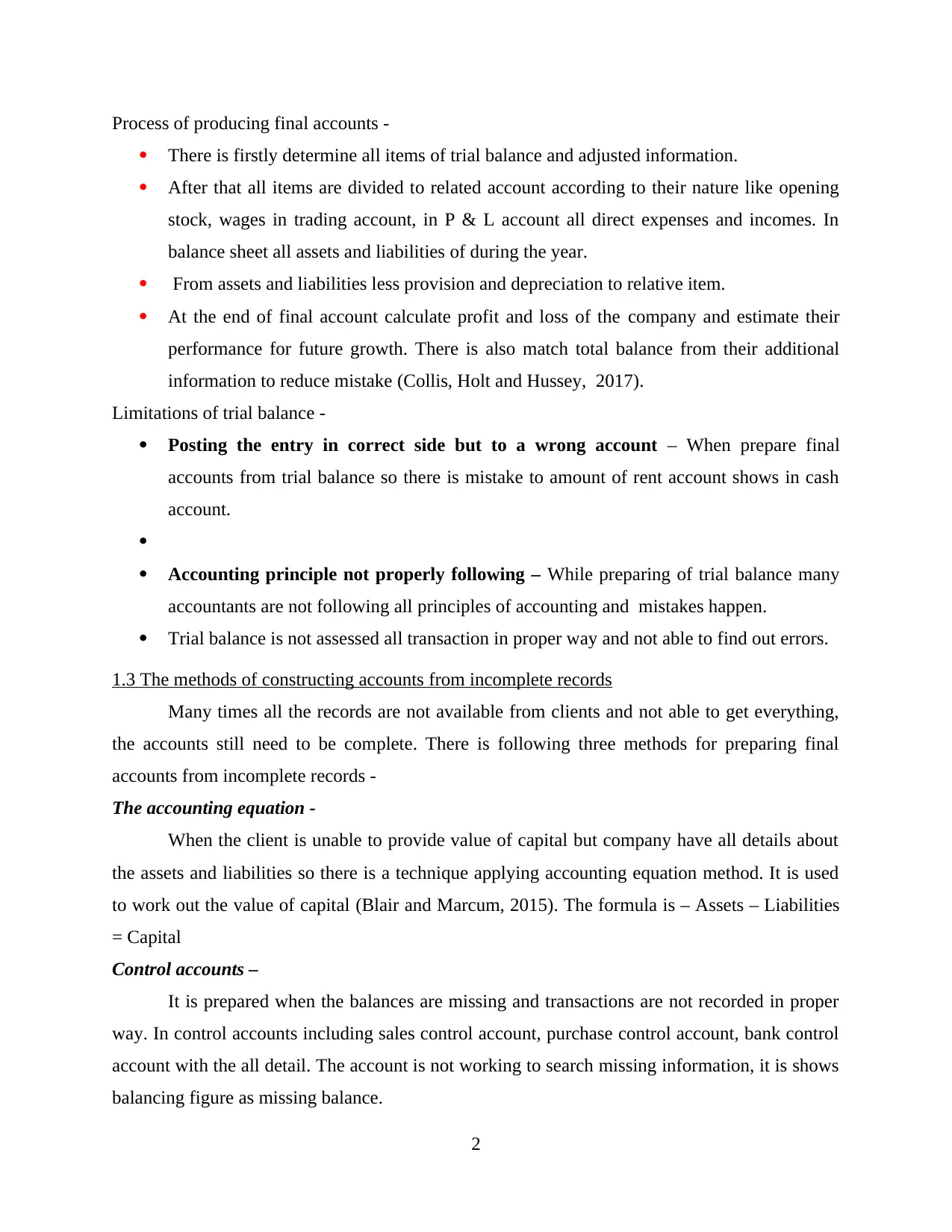
Process of producing final accounts -
There is firstly determine all items of trial balance and adjusted information.
After that all items are divided to related account according to their nature like opening
stock, wages in trading account, in P & L account all direct expenses and incomes. In
balance sheet all assets and liabilities of during the year.
From assets and liabilities less provision and depreciation to relative item.
At the end of final account calculate profit and loss of the company and estimate their
performance for future growth. There is also match total balance from their additional
information to reduce mistake (Collis, Holt and Hussey, 2017).
Limitations of trial balance -
Posting the entry in correct side but to a wrong account – When prepare final
accounts from trial balance so there is mistake to amount of rent account shows in cash
account.
Accounting principle not properly following – While preparing of trial balance many
accountants are not following all principles of accounting and mistakes happen.
Trial balance is not assessed all transaction in proper way and not able to find out errors.
1.3 The methods of constructing accounts from incomplete records
Many times all the records are not available from clients and not able to get everything,
the accounts still need to be complete. There is following three methods for preparing final
accounts from incomplete records -
The accounting equation -
When the client is unable to provide value of capital but company have all details about
the assets and liabilities so there is a technique applying accounting equation method. It is used
to work out the value of capital (Blair and Marcum, 2015). The formula is – Assets – Liabilities
= Capital
Control accounts –
It is prepared when the balances are missing and transactions are not recorded in proper
way. In control accounts including sales control account, purchase control account, bank control
account with the all detail. The account is not working to search missing information, it is shows
balancing figure as missing balance.
2
There is firstly determine all items of trial balance and adjusted information.
After that all items are divided to related account according to their nature like opening
stock, wages in trading account, in P & L account all direct expenses and incomes. In
balance sheet all assets and liabilities of during the year.
From assets and liabilities less provision and depreciation to relative item.
At the end of final account calculate profit and loss of the company and estimate their
performance for future growth. There is also match total balance from their additional
information to reduce mistake (Collis, Holt and Hussey, 2017).
Limitations of trial balance -
Posting the entry in correct side but to a wrong account – When prepare final
accounts from trial balance so there is mistake to amount of rent account shows in cash
account.
Accounting principle not properly following – While preparing of trial balance many
accountants are not following all principles of accounting and mistakes happen.
Trial balance is not assessed all transaction in proper way and not able to find out errors.
1.3 The methods of constructing accounts from incomplete records
Many times all the records are not available from clients and not able to get everything,
the accounts still need to be complete. There is following three methods for preparing final
accounts from incomplete records -
The accounting equation -
When the client is unable to provide value of capital but company have all details about
the assets and liabilities so there is a technique applying accounting equation method. It is used
to work out the value of capital (Blair and Marcum, 2015). The formula is – Assets – Liabilities
= Capital
Control accounts –
It is prepared when the balances are missing and transactions are not recorded in proper
way. In control accounts including sales control account, purchase control account, bank control
account with the all detail. The account is not working to search missing information, it is shows
balancing figure as missing balance.
2
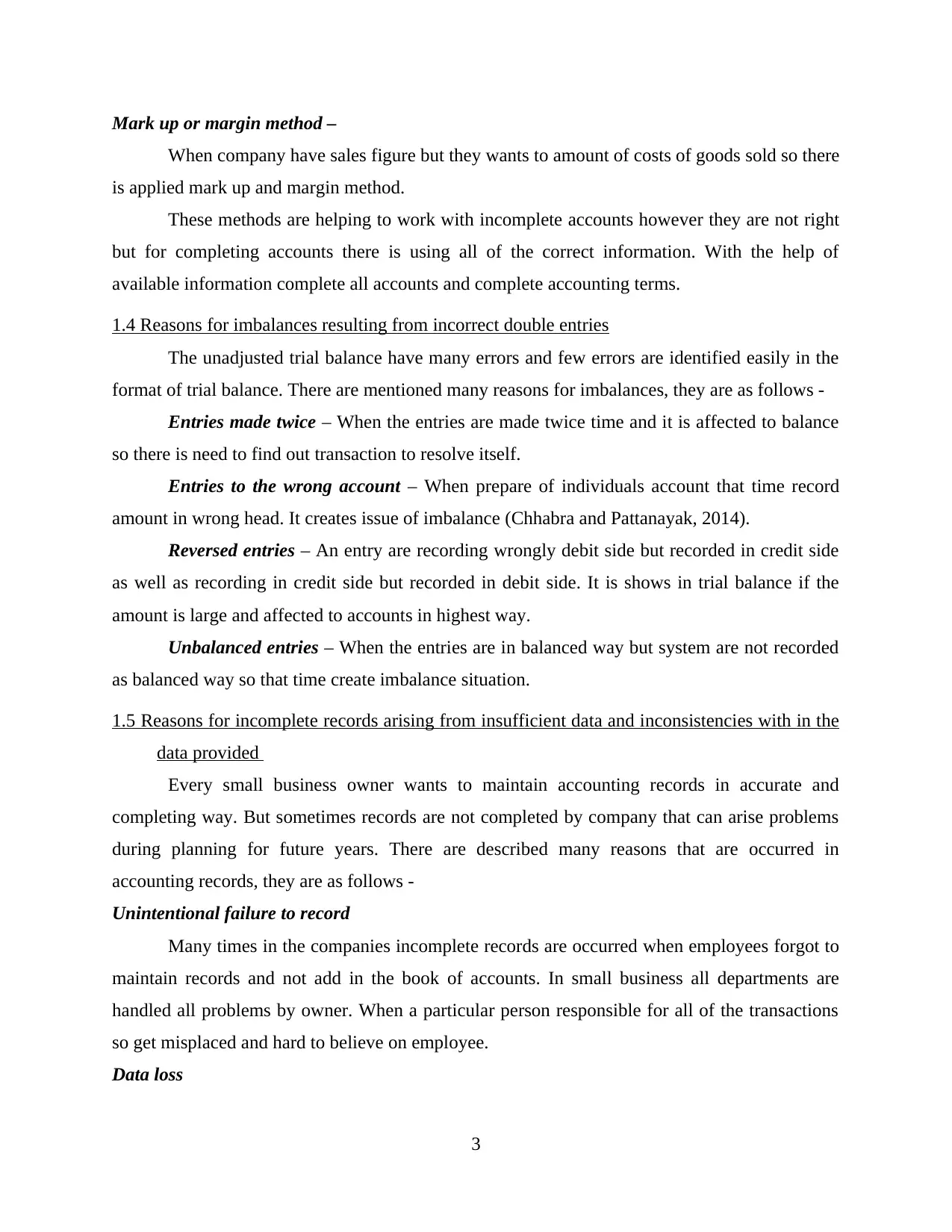
Mark up or margin method –
When company have sales figure but they wants to amount of costs of goods sold so there
is applied mark up and margin method.
These methods are helping to work with incomplete accounts however they are not right
but for completing accounts there is using all of the correct information. With the help of
available information complete all accounts and complete accounting terms.
1.4 Reasons for imbalances resulting from incorrect double entries
The unadjusted trial balance have many errors and few errors are identified easily in the
format of trial balance. There are mentioned many reasons for imbalances, they are as follows -
Entries made twice – When the entries are made twice time and it is affected to balance
so there is need to find out transaction to resolve itself.
Entries to the wrong account – When prepare of individuals account that time record
amount in wrong head. It creates issue of imbalance (Chhabra and Pattanayak, 2014).
Reversed entries – An entry are recording wrongly debit side but recorded in credit side
as well as recording in credit side but recorded in debit side. It is shows in trial balance if the
amount is large and affected to accounts in highest way.
Unbalanced entries – When the entries are in balanced way but system are not recorded
as balanced way so that time create imbalance situation.
1.5 Reasons for incomplete records arising from insufficient data and inconsistencies with in the
data provided
Every small business owner wants to maintain accounting records in accurate and
completing way. But sometimes records are not completed by company that can arise problems
during planning for future years. There are described many reasons that are occurred in
accounting records, they are as follows -
Unintentional failure to record
Many times in the companies incomplete records are occurred when employees forgot to
maintain records and not add in the book of accounts. In small business all departments are
handled all problems by owner. When a particular person responsible for all of the transactions
so get misplaced and hard to believe on employee.
Data loss
3
When company have sales figure but they wants to amount of costs of goods sold so there
is applied mark up and margin method.
These methods are helping to work with incomplete accounts however they are not right
but for completing accounts there is using all of the correct information. With the help of
available information complete all accounts and complete accounting terms.
1.4 Reasons for imbalances resulting from incorrect double entries
The unadjusted trial balance have many errors and few errors are identified easily in the
format of trial balance. There are mentioned many reasons for imbalances, they are as follows -
Entries made twice – When the entries are made twice time and it is affected to balance
so there is need to find out transaction to resolve itself.
Entries to the wrong account – When prepare of individuals account that time record
amount in wrong head. It creates issue of imbalance (Chhabra and Pattanayak, 2014).
Reversed entries – An entry are recording wrongly debit side but recorded in credit side
as well as recording in credit side but recorded in debit side. It is shows in trial balance if the
amount is large and affected to accounts in highest way.
Unbalanced entries – When the entries are in balanced way but system are not recorded
as balanced way so that time create imbalance situation.
1.5 Reasons for incomplete records arising from insufficient data and inconsistencies with in the
data provided
Every small business owner wants to maintain accounting records in accurate and
completing way. But sometimes records are not completed by company that can arise problems
during planning for future years. There are described many reasons that are occurred in
accounting records, they are as follows -
Unintentional failure to record
Many times in the companies incomplete records are occurred when employees forgot to
maintain records and not add in the book of accounts. In small business all departments are
handled all problems by owner. When a particular person responsible for all of the transactions
so get misplaced and hard to believe on employee.
Data loss
3
⊘ This is a preview!⊘
Do you want full access?
Subscribe today to unlock all pages.

Trusted by 1+ million students worldwide
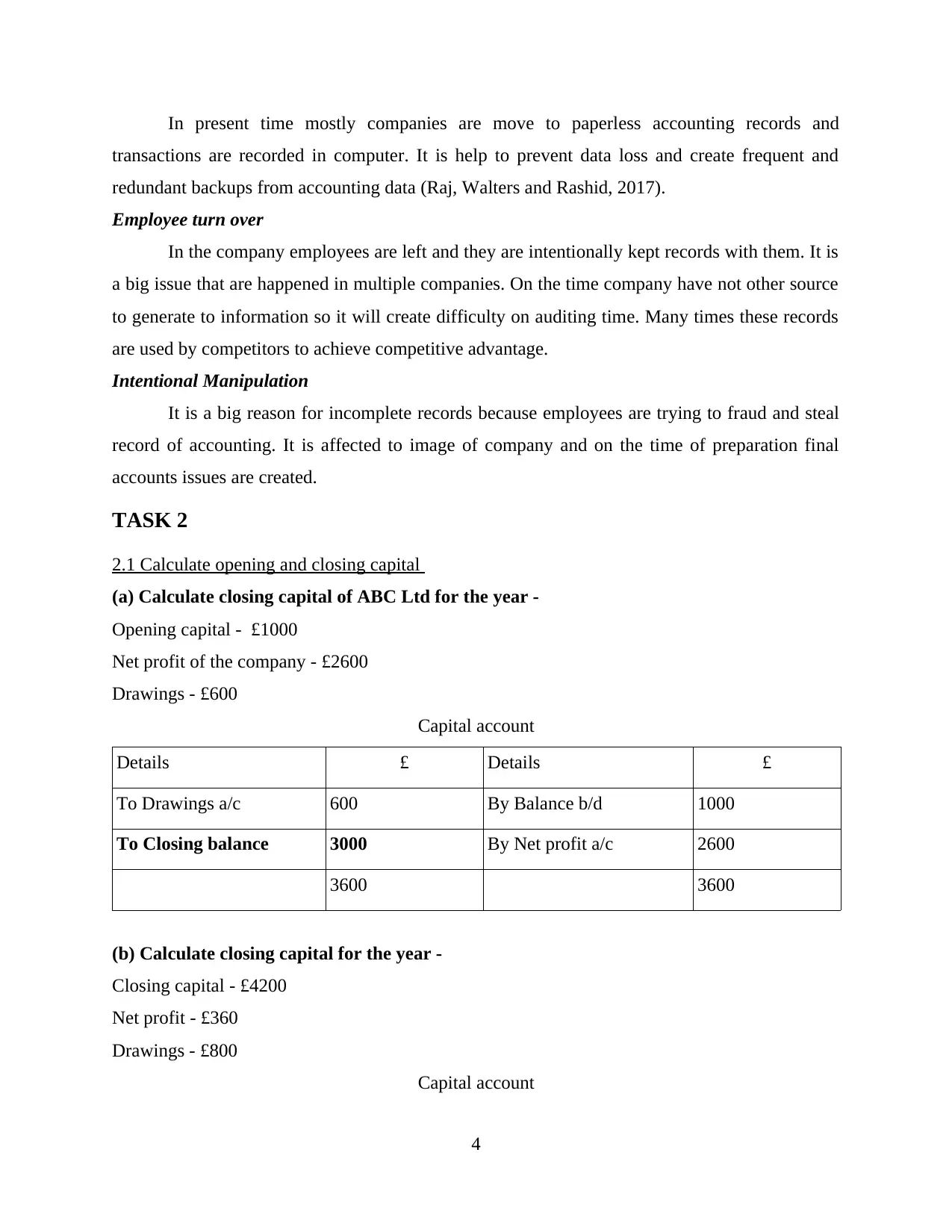
In present time mostly companies are move to paperless accounting records and
transactions are recorded in computer. It is help to prevent data loss and create frequent and
redundant backups from accounting data (Raj, Walters and Rashid, 2017).
Employee turn over
In the company employees are left and they are intentionally kept records with them. It is
a big issue that are happened in multiple companies. On the time company have not other source
to generate to information so it will create difficulty on auditing time. Many times these records
are used by competitors to achieve competitive advantage.
Intentional Manipulation
It is a big reason for incomplete records because employees are trying to fraud and steal
record of accounting. It is affected to image of company and on the time of preparation final
accounts issues are created.
TASK 2
2.1 Calculate opening and closing capital
(a) Calculate closing capital of ABC Ltd for the year -
Opening capital - £1000
Net profit of the company - £2600
Drawings - £600
Capital account
Details £ Details £
To Drawings a/c 600 By Balance b/d 1000
To Closing balance 3000 By Net profit a/c 2600
3600 3600
(b) Calculate closing capital for the year -
Closing capital - £4200
Net profit - £360
Drawings - £800
Capital account
4
transactions are recorded in computer. It is help to prevent data loss and create frequent and
redundant backups from accounting data (Raj, Walters and Rashid, 2017).
Employee turn over
In the company employees are left and they are intentionally kept records with them. It is
a big issue that are happened in multiple companies. On the time company have not other source
to generate to information so it will create difficulty on auditing time. Many times these records
are used by competitors to achieve competitive advantage.
Intentional Manipulation
It is a big reason for incomplete records because employees are trying to fraud and steal
record of accounting. It is affected to image of company and on the time of preparation final
accounts issues are created.
TASK 2
2.1 Calculate opening and closing capital
(a) Calculate closing capital of ABC Ltd for the year -
Opening capital - £1000
Net profit of the company - £2600
Drawings - £600
Capital account
Details £ Details £
To Drawings a/c 600 By Balance b/d 1000
To Closing balance 3000 By Net profit a/c 2600
3600 3600
(b) Calculate closing capital for the year -
Closing capital - £4200
Net profit - £360
Drawings - £800
Capital account
4
Paraphrase This Document
Need a fresh take? Get an instant paraphrase of this document with our AI Paraphraser
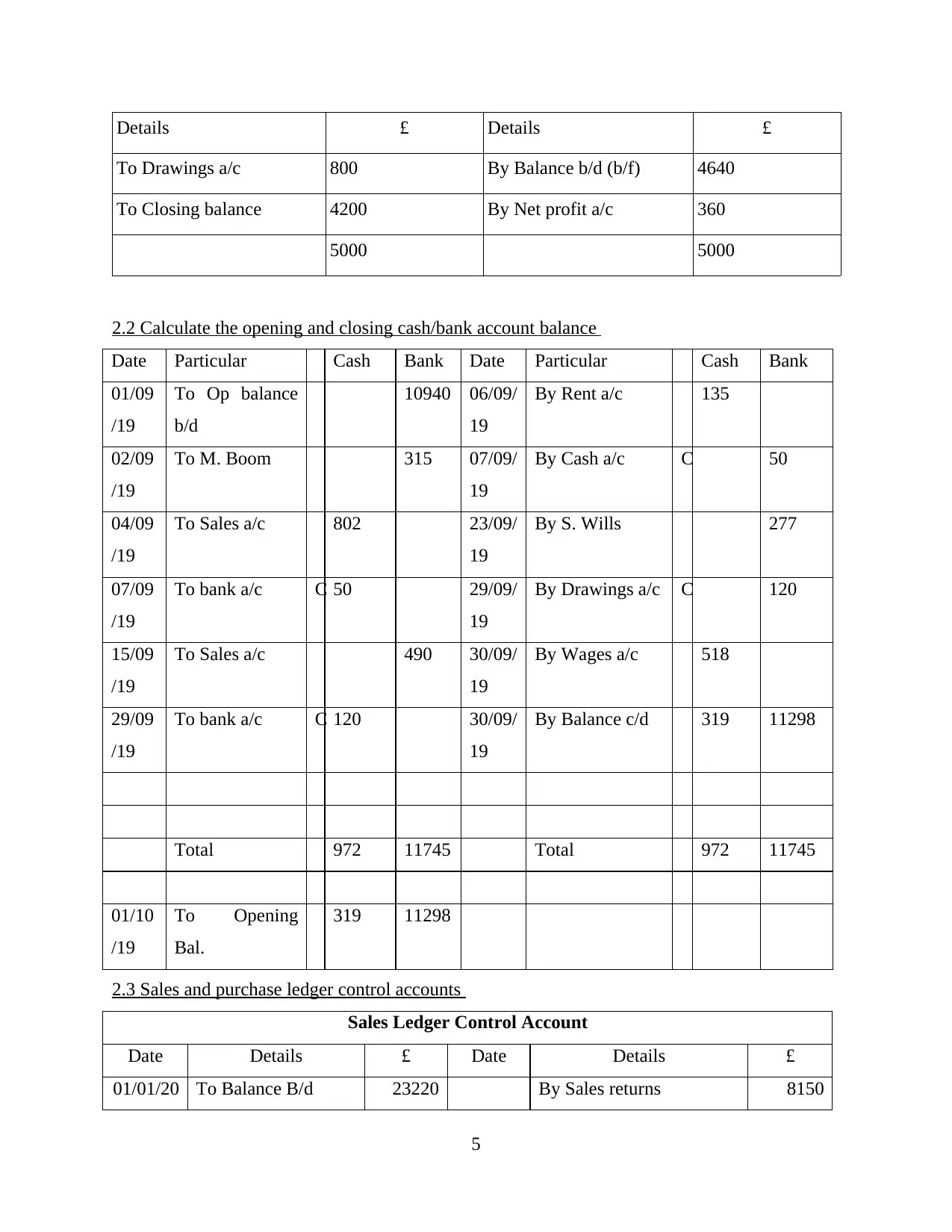
Details £ Details £
To Drawings a/c 800 By Balance b/d (b/f) 4640
To Closing balance 4200 By Net profit a/c 360
5000 5000
2.2 Calculate the opening and closing cash/bank account balance
Date Particular Cash Bank Date Particular Cash Bank
01/09
/19
To Op balance
b/d
10940 06/09/
19
By Rent a/c 135
02/09
/19
To M. Boom 315 07/09/
19
By Cash a/c C 50
04/09
/19
To Sales a/c 802 23/09/
19
By S. Wills 277
07/09
/19
To bank a/c C 50 29/09/
19
By Drawings a/c C 120
15/09
/19
To Sales a/c 490 30/09/
19
By Wages a/c 518
29/09
/19
To bank a/c C 120 30/09/
19
By Balance c/d 319 11298
Total 972 11745 Total 972 11745
01/10
/19
To Opening
Bal.
319 11298
2.3 Sales and purchase ledger control accounts
Sales Ledger Control Account
Date Details £ Date Details £
01/01/20 To Balance B/d 23220 By Sales returns 8150
5
To Drawings a/c 800 By Balance b/d (b/f) 4640
To Closing balance 4200 By Net profit a/c 360
5000 5000
2.2 Calculate the opening and closing cash/bank account balance
Date Particular Cash Bank Date Particular Cash Bank
01/09
/19
To Op balance
b/d
10940 06/09/
19
By Rent a/c 135
02/09
/19
To M. Boom 315 07/09/
19
By Cash a/c C 50
04/09
/19
To Sales a/c 802 23/09/
19
By S. Wills 277
07/09
/19
To bank a/c C 50 29/09/
19
By Drawings a/c C 120
15/09
/19
To Sales a/c 490 30/09/
19
By Wages a/c 518
29/09
/19
To bank a/c C 120 30/09/
19
By Balance c/d 319 11298
Total 972 11745 Total 972 11745
01/10
/19
To Opening
Bal.
319 11298
2.3 Sales and purchase ledger control accounts
Sales Ledger Control Account
Date Details £ Date Details £
01/01/20 To Balance B/d 23220 By Sales returns 8150
5
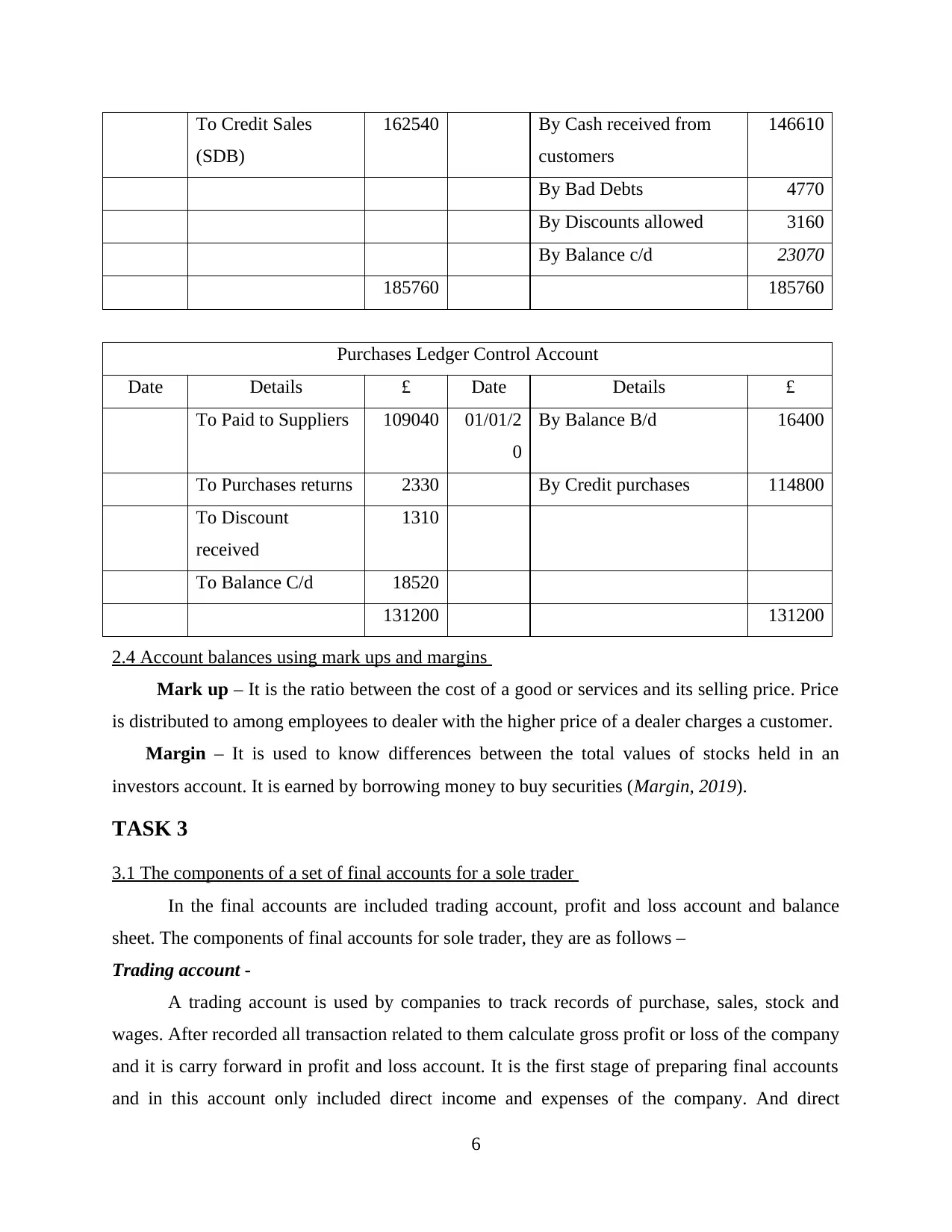
To Credit Sales
(SDB)
162540 By Cash received from
customers
146610
By Bad Debts 4770
By Discounts allowed 3160
By Balance c/d 23070
185760 185760
Purchases Ledger Control Account
Date Details £ Date Details £
To Paid to Suppliers 109040 01/01/2
0
By Balance B/d 16400
To Purchases returns 2330 By Credit purchases 114800
To Discount
received
1310
To Balance C/d 18520
131200 131200
2.4 Account balances using mark ups and margins
Mark up – It is the ratio between the cost of a good or services and its selling price. Price
is distributed to among employees to dealer with the higher price of a dealer charges a customer.
Margin – It is used to know differences between the total values of stocks held in an
investors account. It is earned by borrowing money to buy securities (Margin, 2019).
TASK 3
3.1 The components of a set of final accounts for a sole trader
In the final accounts are included trading account, profit and loss account and balance
sheet. The components of final accounts for sole trader, they are as follows –
Trading account -
A trading account is used by companies to track records of purchase, sales, stock and
wages. After recorded all transaction related to them calculate gross profit or loss of the company
and it is carry forward in profit and loss account. It is the first stage of preparing final accounts
and in this account only included direct income and expenses of the company. And direct
6
(SDB)
162540 By Cash received from
customers
146610
By Bad Debts 4770
By Discounts allowed 3160
By Balance c/d 23070
185760 185760
Purchases Ledger Control Account
Date Details £ Date Details £
To Paid to Suppliers 109040 01/01/2
0
By Balance B/d 16400
To Purchases returns 2330 By Credit purchases 114800
To Discount
received
1310
To Balance C/d 18520
131200 131200
2.4 Account balances using mark ups and margins
Mark up – It is the ratio between the cost of a good or services and its selling price. Price
is distributed to among employees to dealer with the higher price of a dealer charges a customer.
Margin – It is used to know differences between the total values of stocks held in an
investors account. It is earned by borrowing money to buy securities (Margin, 2019).
TASK 3
3.1 The components of a set of final accounts for a sole trader
In the final accounts are included trading account, profit and loss account and balance
sheet. The components of final accounts for sole trader, they are as follows –
Trading account -
A trading account is used by companies to track records of purchase, sales, stock and
wages. After recorded all transaction related to them calculate gross profit or loss of the company
and it is carry forward in profit and loss account. It is the first stage of preparing final accounts
and in this account only included direct income and expenses of the company. And direct
6
⊘ This is a preview!⊘
Do you want full access?
Subscribe today to unlock all pages.

Trusted by 1+ million students worldwide
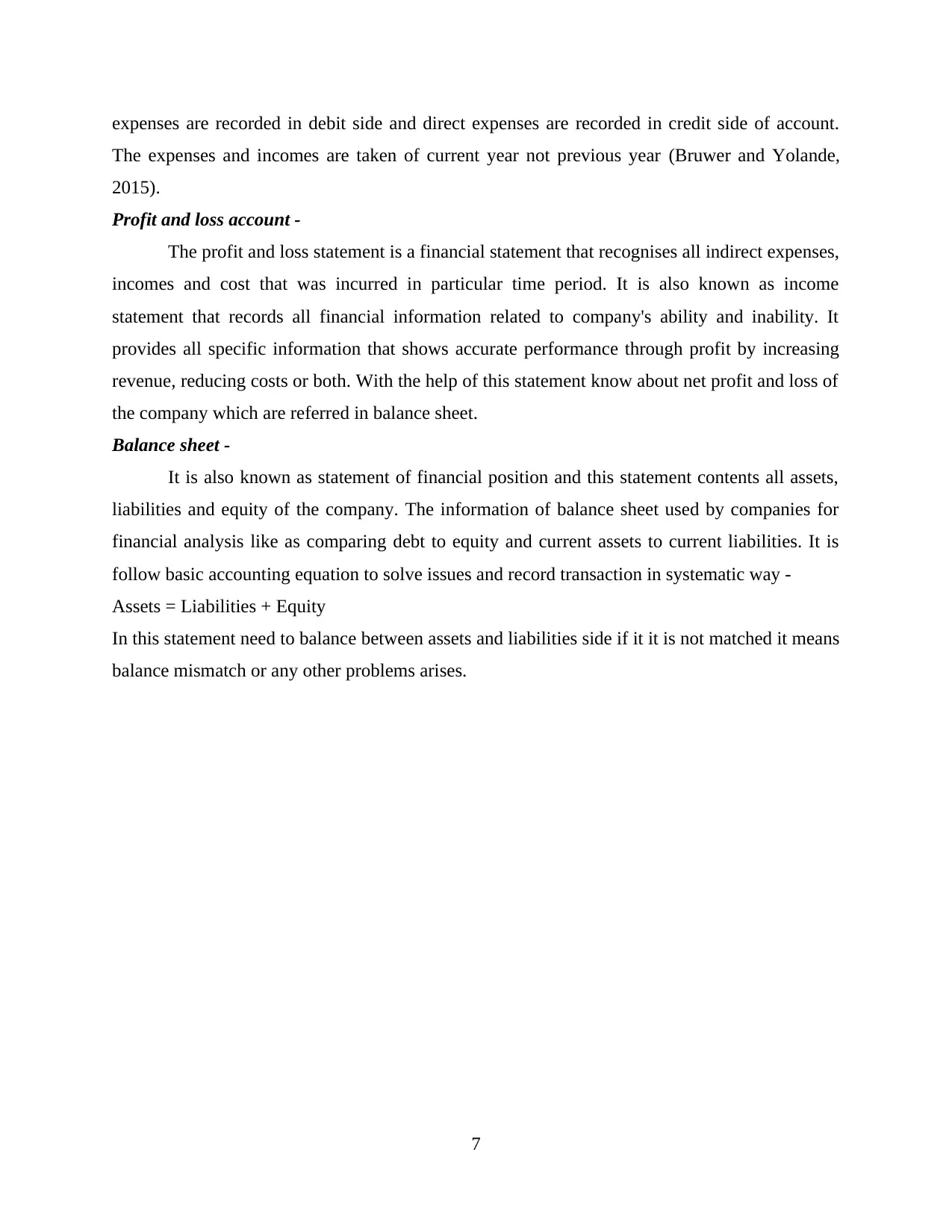
expenses are recorded in debit side and direct expenses are recorded in credit side of account.
The expenses and incomes are taken of current year not previous year (Bruwer and Yolande,
2015).
Profit and loss account -
The profit and loss statement is a financial statement that recognises all indirect expenses,
incomes and cost that was incurred in particular time period. It is also known as income
statement that records all financial information related to company's ability and inability. It
provides all specific information that shows accurate performance through profit by increasing
revenue, reducing costs or both. With the help of this statement know about net profit and loss of
the company which are referred in balance sheet.
Balance sheet -
It is also known as statement of financial position and this statement contents all assets,
liabilities and equity of the company. The information of balance sheet used by companies for
financial analysis like as comparing debt to equity and current assets to current liabilities. It is
follow basic accounting equation to solve issues and record transaction in systematic way -
Assets = Liabilities + Equity
In this statement need to balance between assets and liabilities side if it it is not matched it means
balance mismatch or any other problems arises.
7
The expenses and incomes are taken of current year not previous year (Bruwer and Yolande,
2015).
Profit and loss account -
The profit and loss statement is a financial statement that recognises all indirect expenses,
incomes and cost that was incurred in particular time period. It is also known as income
statement that records all financial information related to company's ability and inability. It
provides all specific information that shows accurate performance through profit by increasing
revenue, reducing costs or both. With the help of this statement know about net profit and loss of
the company which are referred in balance sheet.
Balance sheet -
It is also known as statement of financial position and this statement contents all assets,
liabilities and equity of the company. The information of balance sheet used by companies for
financial analysis like as comparing debt to equity and current assets to current liabilities. It is
follow basic accounting equation to solve issues and record transaction in systematic way -
Assets = Liabilities + Equity
In this statement need to balance between assets and liabilities side if it it is not matched it means
balance mismatch or any other problems arises.
7
Paraphrase This Document
Need a fresh take? Get an instant paraphrase of this document with our AI Paraphraser
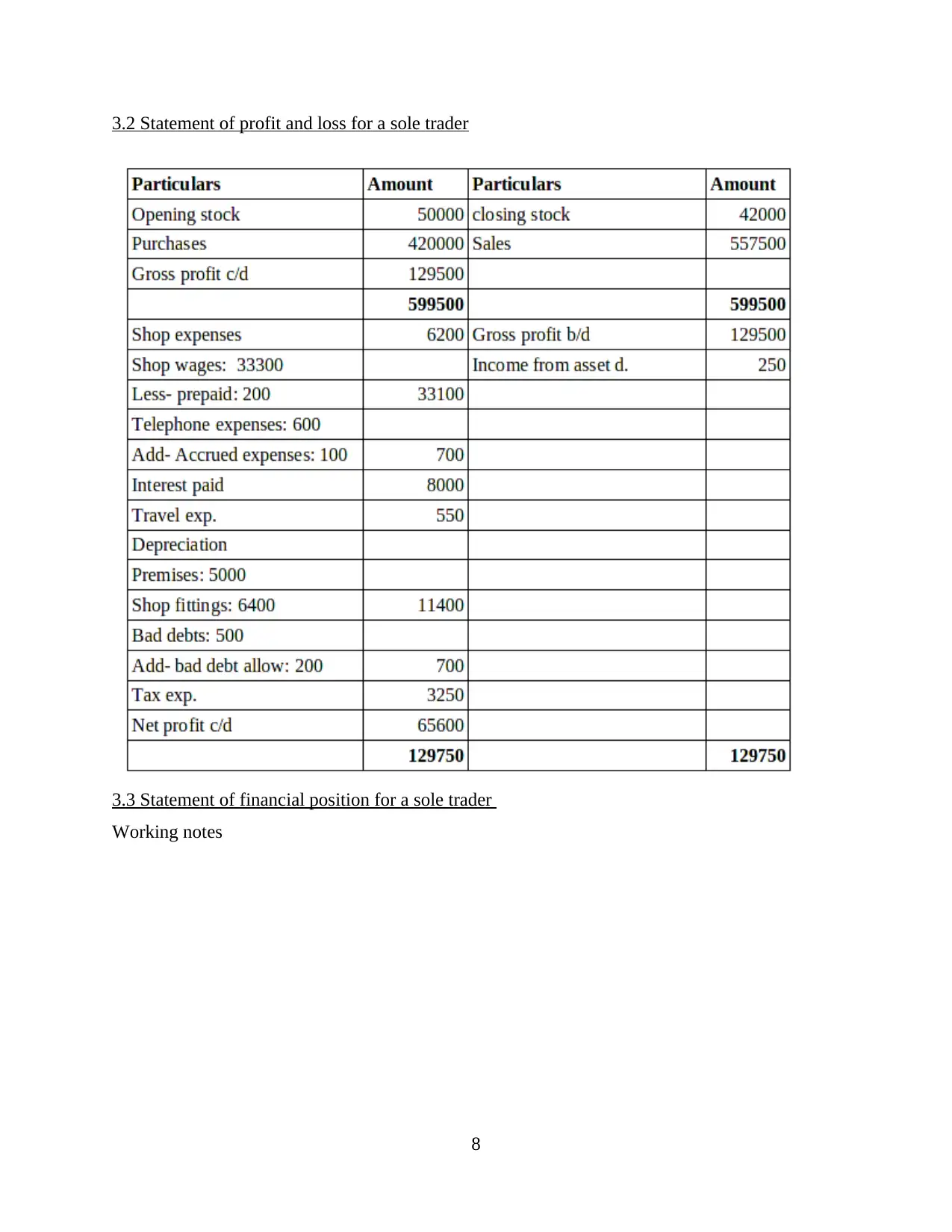
3.2 Statement of profit and loss for a sole trader
3.3 Statement of financial position for a sole trader
Working notes
8
3.3 Statement of financial position for a sole trader
Working notes
8
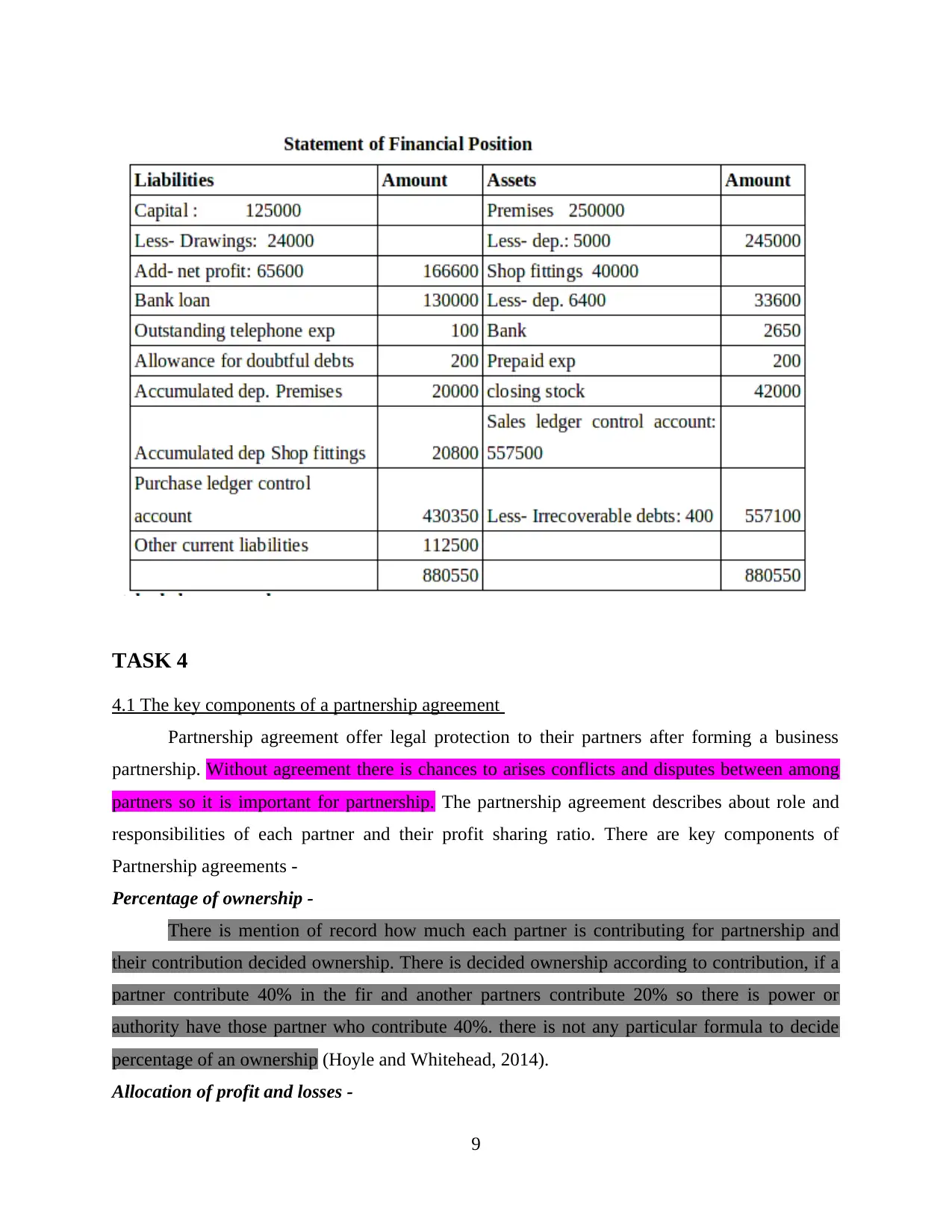
TASK 4
4.1 The key components of a partnership agreement
Partnership agreement offer legal protection to their partners after forming a business
partnership. Without agreement there is chances to arises conflicts and disputes between among
partners so it is important for partnership. The partnership agreement describes about role and
responsibilities of each partner and their profit sharing ratio. There are key components of
Partnership agreements -
Percentage of ownership -
There is mention of record how much each partner is contributing for partnership and
their contribution decided ownership. There is decided ownership according to contribution, if a
partner contribute 40% in the fir and another partners contribute 20% so there is power or
authority have those partner who contribute 40%. there is not any particular formula to decide
percentage of an ownership (Hoyle and Whitehead, 2014).
Allocation of profit and losses -
9
4.1 The key components of a partnership agreement
Partnership agreement offer legal protection to their partners after forming a business
partnership. Without agreement there is chances to arises conflicts and disputes between among
partners so it is important for partnership. The partnership agreement describes about role and
responsibilities of each partner and their profit sharing ratio. There are key components of
Partnership agreements -
Percentage of ownership -
There is mention of record how much each partner is contributing for partnership and
their contribution decided ownership. There is decided ownership according to contribution, if a
partner contribute 40% in the fir and another partners contribute 20% so there is power or
authority have those partner who contribute 40%. there is not any particular formula to decide
percentage of an ownership (Hoyle and Whitehead, 2014).
Allocation of profit and losses -
9
⊘ This is a preview!⊘
Do you want full access?
Subscribe today to unlock all pages.

Trusted by 1+ million students worldwide
1 out of 18
Related Documents
Your All-in-One AI-Powered Toolkit for Academic Success.
+13062052269
info@desklib.com
Available 24*7 on WhatsApp / Email
![[object Object]](/_next/static/media/star-bottom.7253800d.svg)
Unlock your academic potential
Copyright © 2020–2025 A2Z Services. All Rights Reserved. Developed and managed by ZUCOL.





